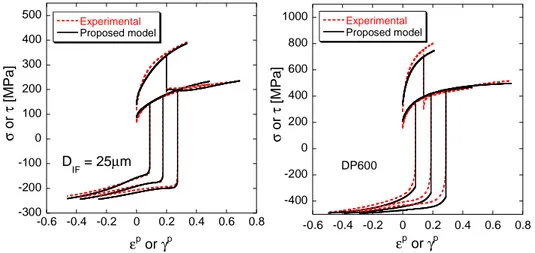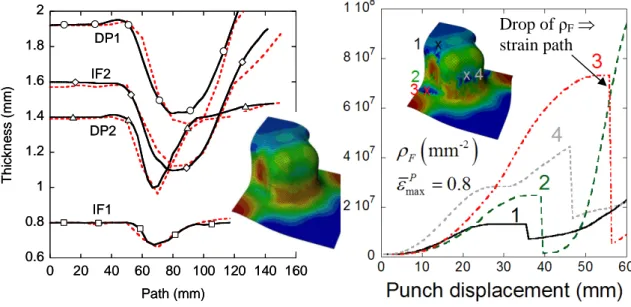Science Arts & Métiers (SAM)
is an open access repository that collects the work of Arts et Métiers Institute of Technology researchers and makes it freely available over the web where possible.
This is an author-deposited version published in: https://sam.ensam.eu Handle ID: .http://hdl.handle.net/10985/13996
To cite this version :
Salima BOUVIER, Tales CARVALHO RESENDE, Tudor BALAN, Farid ABEDMERAIM
-Modelling the effect of microstructure evolution on the macroscopic behavior of single phase and dual phase steels: Application to sheet forming process - 2015
Any correspondence concerning this service should be sent to the repository Administrator : archiveouverte@ensam.eu
MODELLING THE EFFECT OF MICROSTRUCTURE EVOLUTION
ON THE MACROSCOPIC BEHAVIOR OF SINGLE PHASE AND
DUAL PHASE STEELS. APPLICATION TO SHEET FORMING
PROCESS
Salima Bouvier+, Tales Carvalho-Resende+, Tudor Balan++, Farid Abed-Meraim++
+
Roberval Laboratory UMR 6253, University of Technology of Compiegne, Centre de Recherche de Royallieu, Rue Personne de Roberval, 60205 Compiegne, France,
salima.bouvier@utc.fr , tales.carvalho.resende@hotmail.com , ++Arts et Métiers ParisTech, Centre de Metz, Département M2P:Mécanique, Matériaux, Procédés ,
LEM3, 4 rue A. Fresnel, 57078 Metz Cedex 03, France, tudor.balan@ensam.eu ; farid.abed-meraim@ensam.eu.
ABSTRACT- The aim of this work is to develop a dislocation density based model for IF and DP steels that incorporates details of the microstructure evolution at the grain-size scale. The model takes into account (i) the contribution of the chemical composition for the prediction of the initial yield stress, (ii) the description of initial texture anisotropy by incorporating grain-size dependent anisotropy coefficients in Hill’48 yield criterion, (iii) the contribution of three dislocation density “families” that are associated with forward, reverse and latent structures. It reproduces the macroscopic transient behaviors observed when strain-path changes occur. The model is implemented in FE code in order to assess its predictive capabilities in case of industrial applications.
INTRODUCTION: Several experimental studies reported that transient regimes (i.e. Bauschinger effect, work-hardening stagnation and softening) in the macroscopic behavior can be attributed to the evolution of the underlying microstructural details, such as dislocation structures (Gardey et al. [2005]). Moreover, during sheet metal forming processes local material points may experience multi-axial and multi-path loadings. Hence, many researchers focused on physically-based models that take into account the consequence of the evolution of the dislocation structures on the macroscopic behavior in order to predict the effect of strain-path changes. However, when dealing with industrial applications, some other constraints are imposed. Indeed, models (i) have to be user-friendly with limited number of material parameters with strong physical relevance; (ii) should consider “simple” measurable microstructure data such as grain size in input; and (iii) should be time-efficient (low CPU times). Hence, in the present work an innovative approach that accurately estimates steels behavior by only changing few microstructure data (e.g. chemical composition, grain size…) is proposed. The phenomenological hardening model developed in this work incorporates details of the microstructure evolution at the grain-size level based on Kocks-Mecking’s
-300 -200 -100 0 100 200 300 400 500 -0.6 -0.4 -0.2 0 0.2 0.4 0.6 0.8 Experimental Proposed model εp or γp σ o r τ [ M P a ] D IF = 25µm -400 -200 0 200 400 600 800 1000 -0.6 -0.4 -0.2 0 0.2 0.4 0.6 0.8 Experimental Proposed model εp or γp σ o r τ [ M P a ] DP600
approach in order to realistically reproduce the experimentally observed transients in the macroscopic behavior of IF and DP steels after strain-path changes.
PROCEDURES, RESULTS AND DISCUSSION: After realizing mechanical tests that enable displaying macroscopic transient behaviors under monotonic, reverse and non proportional loadings, the predictive capabilities of the developed model are validated on a set of nine IF steels with average grain sizes between 8 and 40µm, and a set of eight DP steels with different martensite volume fractions and average grain sizes between 1 and 10µm. For each category (i.e. single phase ferrite steels or dual phase ferrite-martensite steels), the material parameters are first identified for one “reference” steel (Fig. 1), (i.e. for a given microstructure data). Therefore, the macroscopic behaviors for the other steels are predicted by only changing microstructural data (chemical composition, ferrite and/or martensite grain sizes, martensite volume fraction and chemical composition). Such an approach reduces the time-consuming mechanical tests and identification procedures.
Figure 1. Results of the microstructural model identification procedure: IF steel (left) and DP steel (right).
The developed microstructural phenomenological model is extended to ABAQUS/Explicit through the implementation of a VUMAT subroutine in order to assess its abilities to predict the material behavior. The cross-shape drawing is used for the thickness comparisons between simulations and experiments. The finite element simulations exhibit good predictive capabilities in terms of thickness distribution, draw-in, forming loads (Fig. 2 left). The simulations emphasize that the effect of strain-path changes on thickness distribution becomes relevant only when the amount of the equivalent plastic strain is high enough (Fig. 2 right). Also, this work allowed confirming that the role of the yield criterion is as significant as that of the hardening model. Hence, on the one hand, it was noticed that a good estimation of r-values in highly anisotropic IF steels is suited for simulations accuracy. On the other hand, DP steels turned out to be less sensitive to r-values estimation. Such observations lead us to the following perspective: as anisotropy of materials evolves during deformation, an evolutionary Hill’48 physically-based yield criterion could be developed by introducing the
evolution of r-values.
CONCLUSIONS: A dislocation density based model that incorporates details of the microstructure evolution at the grain-size scale is developed and aims to describe the monotonic and transient work-hardening behavior of IF and DP steels observed experimentally when strain-path changes occur. The model is implemented into ABAQUS via a user subroutine VUMAT in order to assess its predictive capabilities and time efficiency. The effect of strain-path changes modeling during complex deep-drawing is investigated.
Figure 2. (left) Thickness distribution along the rolling direction for different grades of IF single phase and dual phase steels (different initial sheet thicknesses). Dash lines: Exp, Continuous lines: Model. (right) Forward dislocation density ρFdistribution at 60mm punch displacement and evolution (right) for an IF.
ACKNOWLEDGEMENTS: The authors gratefully acknowledge RENAULT for funding this work.
REFERENCES:
Carvalho-Resende T., Balan T., Bouvier S., Abed-Meraim F. and Sablin S.S. (2013), “Numerical investigation and experimental validation of a physically-based plasticity model for sheet steel forming”, Modelling Simul. Mat. Sci. Engng. 21.
Yoshida K., Brenner R., Bacroix B. and Bouvier S. (2011), “Micromechanical modelling of work-hardening behavior of single- and dual-phase steels under two-stage loading”, Mat. Sci. Engng. A, 528, 1037.
Gardey B., Bouvier S. and Bacroix B. (2005), “Correlation between the macroscopic behaviour and the microstructural evolutions during large plastic deformation of a dual phase steel”, Met. Mat. Trans. A, 36A, 2937.
0.6 0.8 1 1.2 1.4 1.6 1.8 2 0 20 40 60 80 100 120 140 160 T h ic k n e s s ( m m ) Path (mm) DP1 DP2 IF1 IF2 0.6 0.8 1 1.2 1.4 1.6 1.8 2 0 20 40 60 80 100 120 140 160 T h ic k n e s s ( m m ) Path (mm) DP1 DP2 IF1 IF2 Drop of ρF ⇒ strain path change

